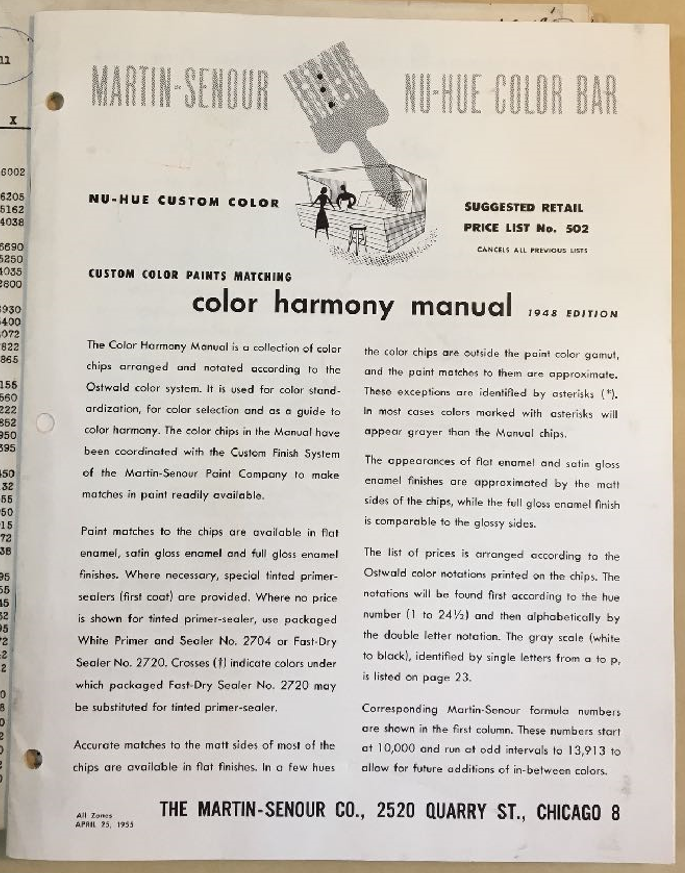In a report for the November 1950 newsletter of the Inter-Society Color Council (ISCC), color consultant Faber Birren enthusiastically announced the Martin-Senour Paint Company’s newly released Nu-Hue color system. This series of custom paints, formulated to match the color chips in Container Corporation of America’s popular Color Harmony Manual, was, according to Birren, “real news.” Developed by Container Corporation’s art director, Egbert Jacobson, in collaboration with color experts Walter Granville and Carl Foss, the Color Harmony Manual used the scientific color theories of German chemist Wilhelm Ostwald to systematize the use of color in painting, printing, dyeing, and designing. Since publication of the first edition in 1942, the Manual had become an industry standard for the specification and coordination of harmonious color schemes. Martin-Senour’s Nu-Hue system extended the Manual’s usefulness by reproducing the colors as readily available, machine-mixed paints. Based on years of research, this technical breakthrough promised to revolutionize any industry involved in the systematic use of color.

Below Birren’s announcement, the ISCC offered a surprising example of Nu-Hue’s utility. Under the provocative headline “Machine Replaces Artist’s Palette,” news of a mural project by Bay Area artist George Harris reached the ISCC’s readership. The project was remarkable, according to the report, because it signaled the first time in history that a major artist had produced “a large-scale mural without mixing a drop of paint.” After completing his initial designs, Harris used the Color Harmony Manual’s 680 color chips to select specific hues, tints, tones, and shades. He sent these selections to Martin-Senour, which in turn provided its San Francisco distributor with precise paint formulas for the specified colors. By the time Harris received his pre-mixed pigments, he had simply to apply them in a paint-by-numbers fashion to the walls of San Francisco’s Chamber of Commerce building. This process was a far cry from the labors of Renaissance fresco painting, or even from the painstaking procedures of Harris’s own mentor, the Mexican muralist Diego Rivera.

By his own account, Harris relished the opportunity to participate in the experimental world of industrialized art making. “There is no reason,” he argued, “why the artist, today, cannot, and should not take advantage of the technical advances of science if he can use them to aid him in the creation of a work of art.” Ever the pragmatist, Harris found that working with pre-mixed paints saved time while affording greater accuracy. He likened the Color Harmony Manual and corresponding Nu-Hue system to the modern composer’s keyboard; rather than restricting the artist’s vision, he argued, these tools served as boons to creative interpretation.

The collaboration between George Harris, Container Corporation’s color experts, and Martin-Senour’s paint mixers exemplifies a growing mid-century convergence of technical innovation, industrial enterprise, and artistic ingenuity. This network of interlocking expertise is at the center of my doctoral work on the history of integrated design, a mid-century attempt to unite designers and businessmen in the coordination of cohesive visual environments. Collaborations between art and business remain relatively understudied, but the Hagley’s collections documenting the history of American corporate culture offer valuable opportunities for filling this lacuna.
Robert Gordon-Fogelson is a doctoral student in art history at the University of Southern California. To support his research, Gordon-Fogelson received an exploratory grant from the Hagley Center for the History of Business, Technology, & Society.
